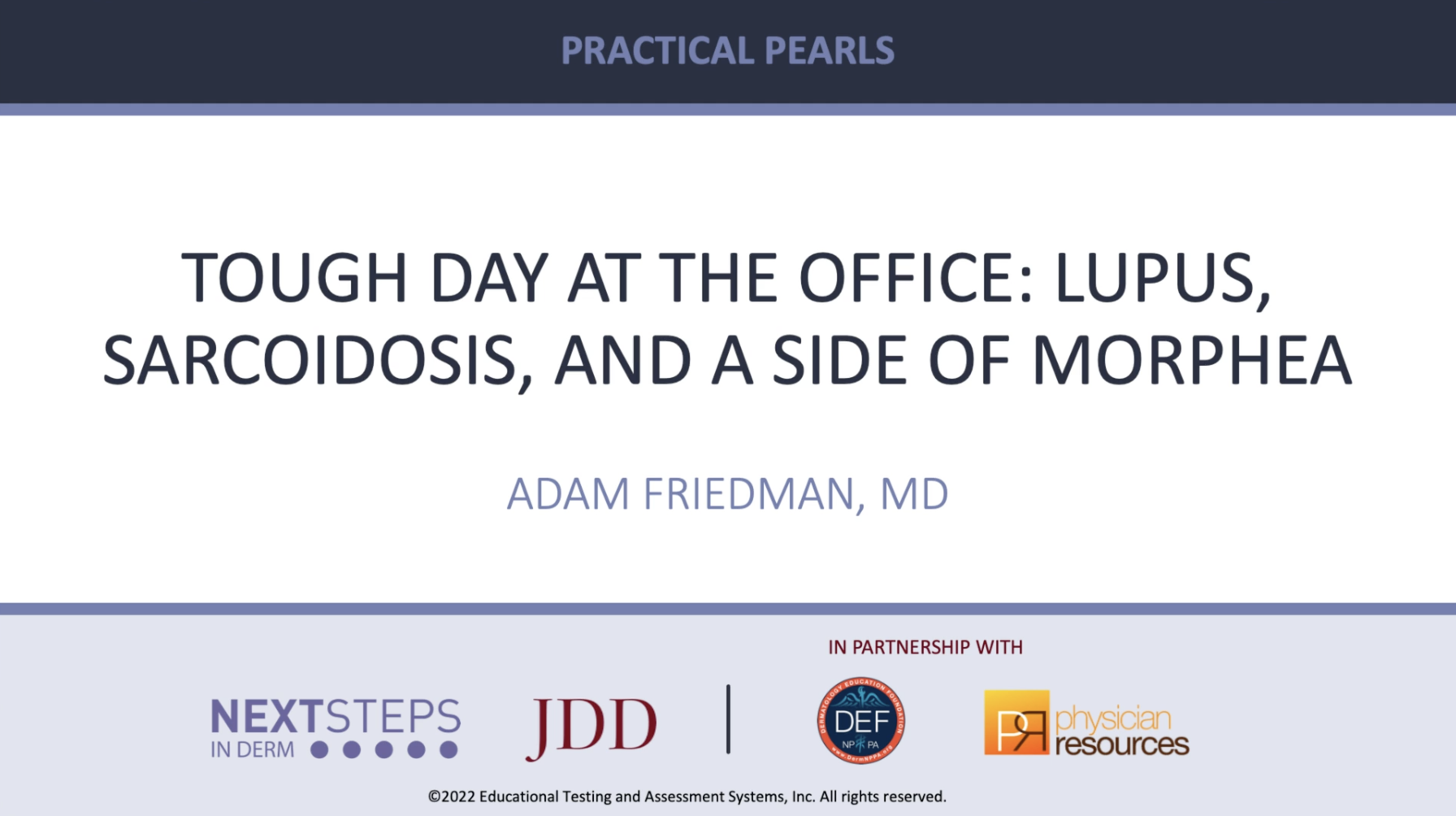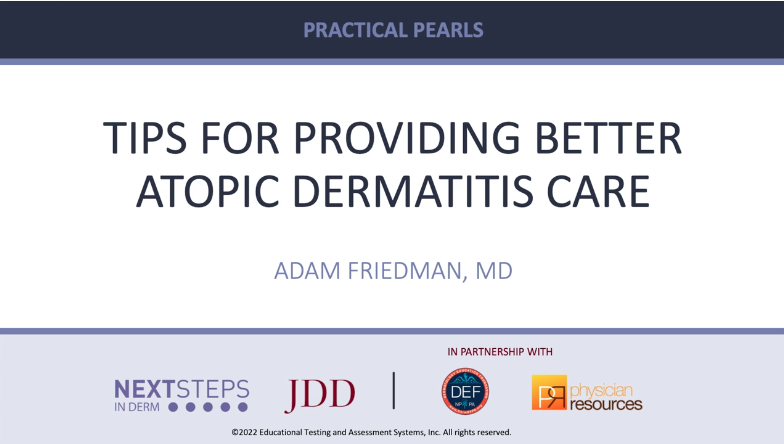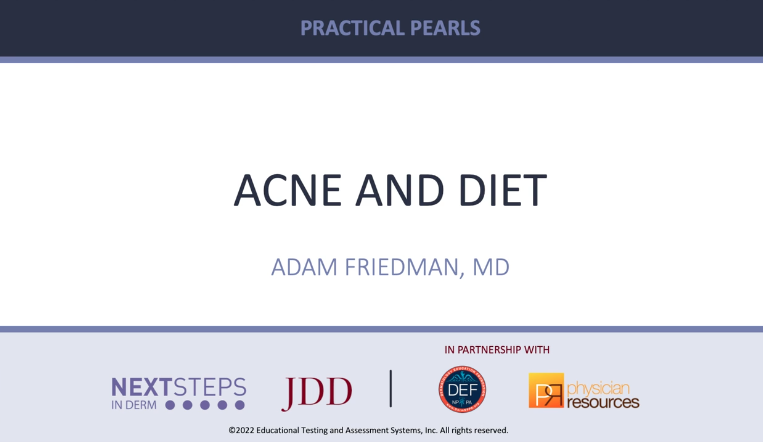Welcome to JDD Corner, your gateway to a world of dermatology knowledge and insights! JDD Corner is a curated collection of video abstracts, editor picks, Key Opinion Leader (KOL) spotlights, trending articles, and much more. Whether you are a dermatologist, a skincare enthusiast, or simply curious about the latest advancements in dermatology, JDD Corner is your one-stop destination for staying informed and up-to-date with the most exciting developments in the field. Explore our carefully selected content and immerse yourself in the dynamic world of dermatology. Welcome to JDD Corner!
JDD Corner
JDD Corner
Video Abstracts
Introducing an Exciting NEW Opportunity for Our Authors to Connect with Our Readership through a Cutting-Edge Media Channel! Email us at editorial@jddonline.com to get started!
NEW! VIDEO ABSTRACT
Perceptions and Recommendations for Sunscreen: A Cross-Sectional Survey of United States Dermatology Healthcare Providers
The dermatology HCPs in this survey strongly support sunscreen use and believe that FDA-approved sunscreens are effective and safe. The social media findings highlight a continued need to improve education on sunscreen use and increase counseling from clinicians on sun protection behaviors.
NEW! VIDEO ABSTRACT
Open-Label Study: Over-the-Counter Oat Flour/Oat Oil/ Oat Extract-containing Lotion With Avenanthramides for Sensitive Skin and Psoriasis
Psoriasis is a common skin condition that affects the physical and emotional well-being of patients. Moisturizers have been shown to significantly improve skin condition and quality of life in this patient population. Skin afflictions such as atopic dermatitis and pruritis share etiological similarities with psoriasis, and oatmeal (Avena sativa)-containing lotion has proven effective in treating the symptoms of those conditions. However, data on the use of an over-the-counter oatmeal-containing lotion alone to treat the symptoms of psoriasis are limited.
NEW! VIDEO ABSTRACT
Skin Barrier Benefits of a Natural Moisturizing Factor and Lipids-Based Moisturizer for Clinically Sensitive Skin
A novel topical cream moisturizer was designed to deliver immediate and long-lasting skin barrier improvements and to improve skin tolerability when used as adjunctive/complementary care by patients with atopic dermatitis (AD), rosacea, or cosmetic intolerance syndrome (CIS), reducing symptoms of skin irritation and sensitivity.
NEW! VIDEO ABSTRACT
Real-World Clinical Case Series Utilizing Acneceuticals as Monotherapy, Adjunctive, or Maintenance Therapy for Acne Vulgaris
Acne vulgaris is a common, multifactorial inflammatory skin disease for which there are many pharmacologic and procedural interventions. Recent publications have stressed the importance of quality skin care containing non-prescription actives (acneceuticals) in the treatment of this chronic disorder.
NEW! VIDEO ABSTRACT
Study of Adjuvant Sensitive-Skin Cleansing/Moisturizing Regimen in Plaque Psoriasis
Epidermal barrier dysfunction is a key feature of plaque psoriasis. Skincare improves epidermal barrier function and is an increasingly recommended part of psoriasis management.
NEW! VIDEO ABSTRACT
Placental Allograft Reconstruction of Cutaneous Wounds Following Mohs Surgery: A Propensity Score-Matched Comparative Cost-Effectiveness Analysis
The purpose of this study was to examine the cost-effectiveness of placental allograft as a nonoperative surrogate to autologous tissue-based methods of defect reconstruction on the face, head, and dorsal hand following Mohs micrographic surgery (MMS).
Author Spotlight
Our current Author Spotlight features Kseniya Kobets MD MHS, one of the co-authors of “Disparities in Hidradentitis Suppurativa Clinical Trials: An Updated Review of ClinicalTrials.gov from 2020 to 2024,” published in JDD’s December 2025 issue. In addition to her article, Dr. Kobets also answered questions around the current state of dermatology and how the field is adapting to new advances in technology and treatments.
Trending Articles
Clindamycin Phosphate 1.2%/Adapalene 0.15%/ Benzoyl Peroxide 3.1% Gel for Moderate-to-Severe Acne: A Pooled Analysis by Age
Acne pathophysiology and presentation may differ between pediatric/adolescent/young adult (9-24 years) and adult (≥25 years) patients. Fixed-dose clindamycin phosphate 1.2%/adapalene 0.15%/benzoyl peroxide 3.1% (CAB) gel demonstrated superior efficacy to vehicle and component dyads with good safety/tolerability in 3 clinical trials of acne. This post hoc analysis evaluated the efficacy/safety of CAB in pediatric/adolescent/young adult (“younger”) vs adult participants.
Isotretinoin Does Not Increase the Risk of Inflammatory Bowel Disease: A TriNetX Retrospective Cohort Analysis
The increasing use of long-term, low-dose isotretinoin for acne has raised concerns about a potential association with inflammatory bowel disease (IBD), including Crohn’s disease and ulcerative colitis.
An Open-Label, Single-Center Proof of Concept Study Evaluating the Efficacy and Safety of Tirzepatide for Moderate to Severe Hidradenitis Suppurativa
Hidradenitis suppurativa (HS) is a chronic inflammatory disease associated with obesity and metabolic dysregulation. Current therapies yield variable benefits and do not target metabolic drivers. Tirzepatide, a dual GLP-1/GIP receptor agonist, induces weight loss and exerts anti-inflammatory effects, offering a potential novel approach for the treatment of HS.
Clinical Evaluation of Thiamidol-Containing Formulations for the Visual Management of Facial Hyperpigmentation
Cutaneous hyperpigmentation, which includes melasma, post-inflammatory hyperpigmentation, and solar lentigines, significantly impacts patients’ quality of life. The overproduction of melanin is mediated by activation of the skin enzyme tyrosinase, leading to excess melanin deposition in the skin. Thiamidol (isobutylamido thiazolyl resorcinol) formulations have been previously shown to be effective in reducing the cutaneous pigmentation associated with this human skin enzyme.
Skin Improvements in Acne Vulgaris Patients Using Gel-Matrix Moisturizer as a Complement to Topical Treatments
In 2006, an article titled “Who benefits from calling a solar keratosis a squamous cell carcinoma” was published in the British Journal of Dermatology. The author, Robin Marks, expressed concern about the risks to patients and the broader community posed by overdiagnosing solar keratoses as true cancers.
Evaluating the Risk of Atherosclerotic Cardiovascular Disease in Inflammatory Skin Disease: Insights From a TriNetX Cohort Study
Recognizing the risk of atherosclerotic cardiovascular disease (ASCVD) in patients is crucial in clinical practice. Recent studies suggest an association between inflammatory skin diseases and ASCVD. This study evaluates ASCVD risk in inflammatory skin disease patients using a standardized assessment model.
Recent News
Editor's Picks
Video Pearls
Tough Day at the Office: Lupus, Sarcoidosis, and a Side of Morphea
Watch as Dr. Friedman shares basic principles to managing three distinct diseases – cutaneous lupus, sarcoidosis and linear morphea. Learn why you need to do a good review of organ systems and be prepared to phone a friend (or more) across the aisle in medicine.
Tips for Providing Better Atopic Dermatitis Care
With the growing list of therapeutic options, Dr. Friedman encourages clinicians to go back to the basics and address one of the greatest challenges — treatment adherence.
Acne and Diet
Adam Friedman, professor and chair of dermatology at GW School of Medicine and Health Sciences. Dr. Friedman says acne is an evidence-based example of the saying “you are what you eat.”
Crushing It In The Capital: Lessons From Residency Translated
Dr. Friedman provides his tips for remaining calm during the craziest of office visits. He also shares why being fun, creative and an off-label bandit matters.
New Innovations in Hyperpigmentation
Dr. Chilukuri outlines at-home and in-office treatments to address hyperpigmentation, including newly developed therapies.












